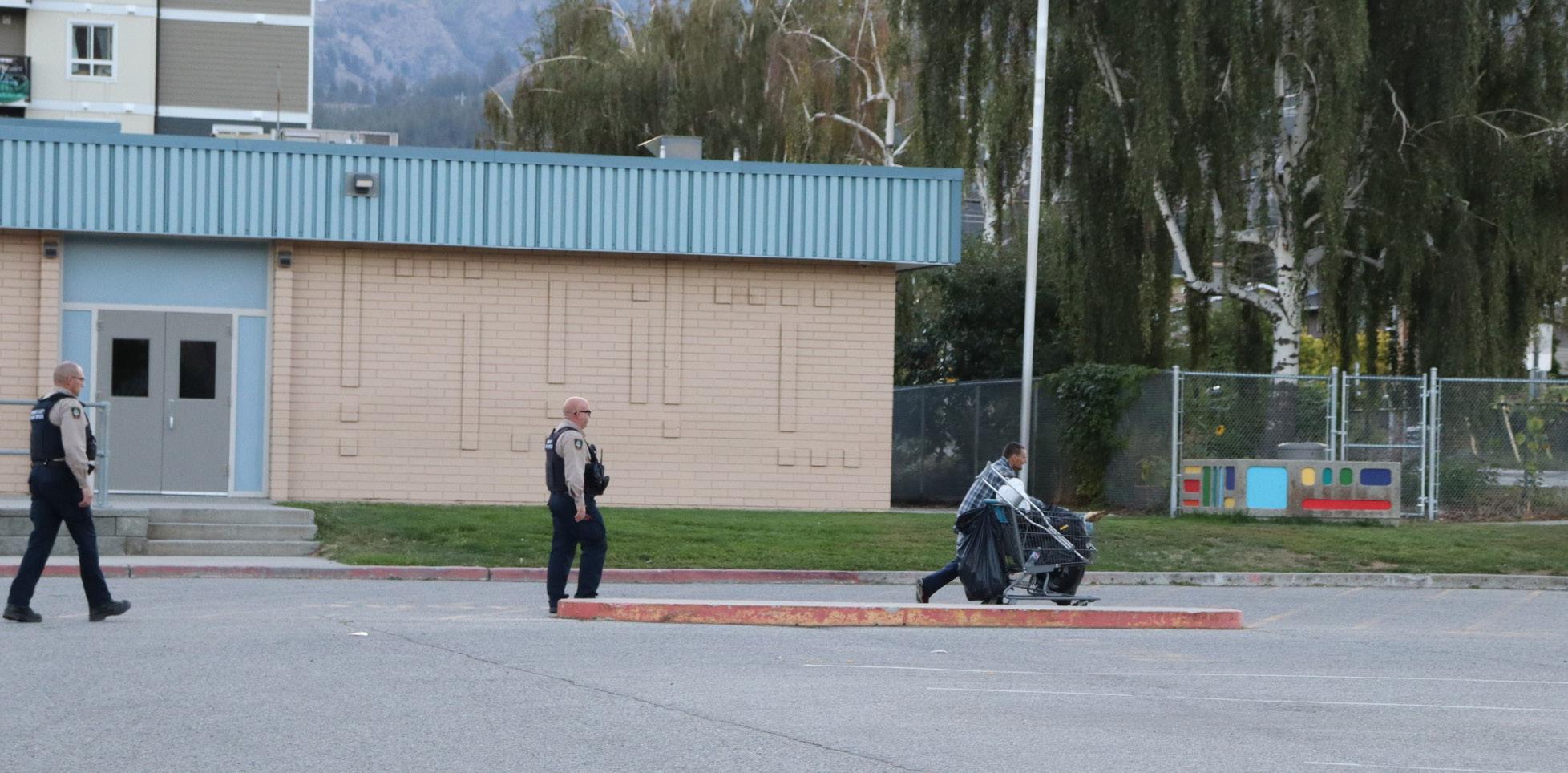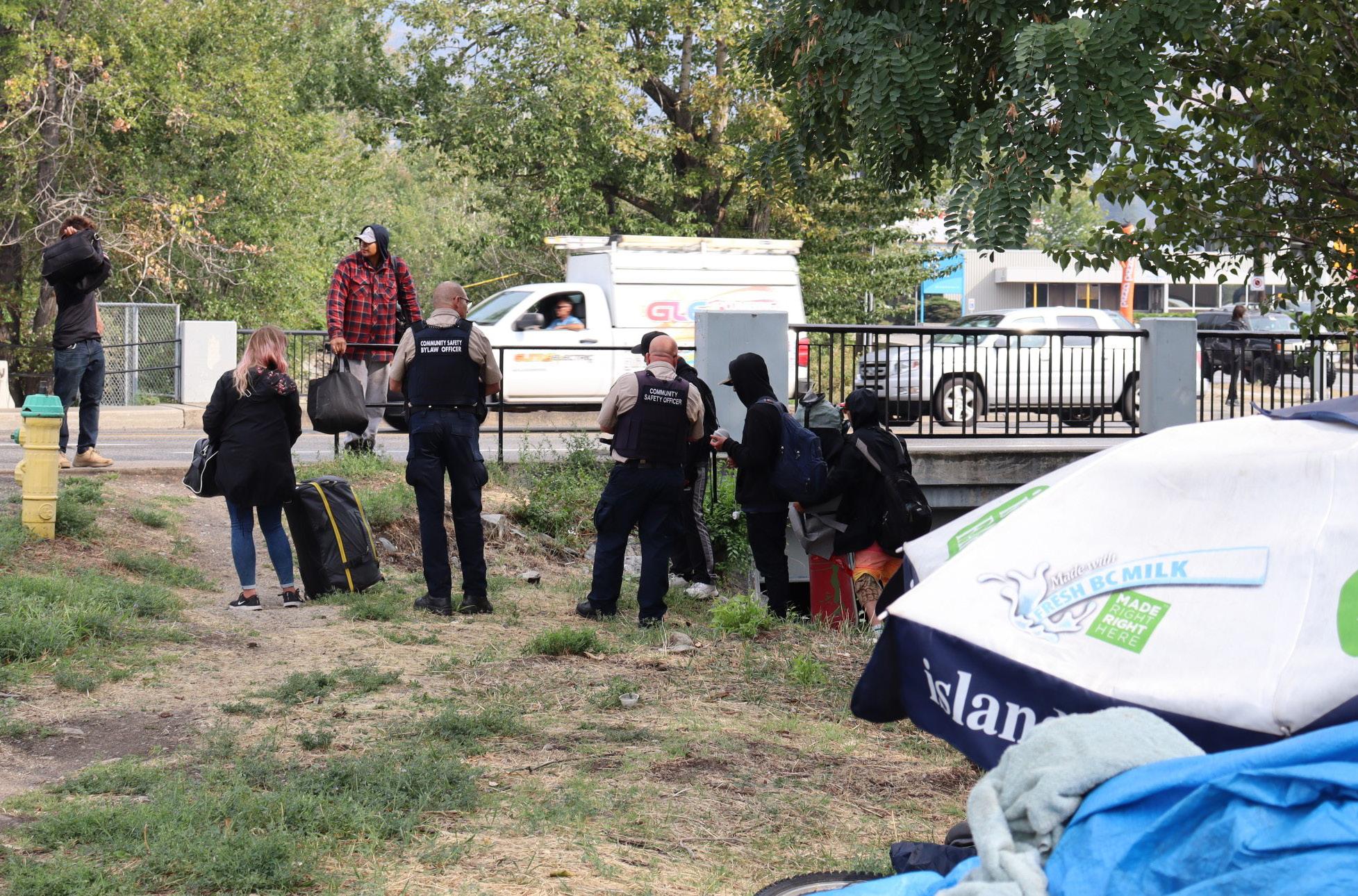A DAY IN THE LIFE


 Community Safety Officers perform a wellness check on an individual wrapped in a poncho, lying on the ground between rows of cedar hedges.
OF PENTICTON'S COMMUNITY SAFETY OFFICERS
Community Safety Officers perform a wellness check on an individual wrapped in a poncho, lying on the ground between rows of cedar hedges.
OF PENTICTON'S COMMUNITY SAFETY OFFICERS
That's the number of calls for services handled by the Community Safety Officer program in 2022. In fact, calls increased 197% between 2020 and 2021. Calls included everything from abandoned property loitering to picking up sharps.
By the numbers, the program is working. The intent of establishing the CSOs and then expanding the scope was to remove less service calls from the RCMP. According to the latest annual report, the RCMP saw a reduction in calls for service by more than 500 in 2022.
But what do CSOs do?
There is no typical day. They act as social workers, clean-up crews, dispute resolution mediators and some- times just a person to show that human touch. There are moments of anguish, adrenaline and aspiration.
Social media often highlights the divide that the program can face. Some see the CSO as an extension of the police and the enemy of those in need. Others think the CSOs are too soft and not doing enough.
Spend time with the CSOs and it is clear that the starting point is caring and building relationships. They know many of the people they have interactions with by name; they work to earn trust which is essential in getting people to follow instructions without situations escalating. And it goes a long way to allow the CSOs, who collaborate with a variety of social agencies, to answer calls for help from those they meet.
As proposed, the new bylaws will give more authority to CSOs when conducting their work - giving them legal authority to enter onto private property and inform people when they are in violation. This will allow them to move people who are panhandling in a drive-thru or camped in at an ATM.
The interactions with people and trying to connect them with services when they can are only part of the job. Cleaning up discarded items, including fishing property tossed into the creeks, is part of the job. Checking for sharps (discarded needles) is a routine part of the job. Exploring wooded areas to see if new encampments have popped up is a regular occurrence.
Many of the interactions are polite but not always. Dangerous items have been pulled, even a machete, and CSOs are trained to de-escalate, protect themselves and call the RCMP for support.
One interaction, though, sums up the CSOs approach to showing the heart, before the hammer.
A CSO, when a woman on the street asked why they were back. "We just came back to see how you're doing."
As day breaks, the first task of the day to provide wake-up calls for those who slept the night outside. Some camp in a group, with various gear to protect against elements. This group will be given a deadline to pack-up and move along, usually around 90 minutes. The intervention from the CSOs isn’t unexpected and so the discussion is straightforward.

6:29 am

6:52 am
Some of those awoken are well-known to the Community Safety Officers, having been long-term residents of the streets.

They’re greeted by name and firmly asked to move along.
7:05 am
Schools are a no-go zone, with the order to depart the area immediately. There’s no grace period, no tolerance for the possibility of sharps or other paraphernalia to be found by children. First spotted on the other side of the field, the cart is pushed quickly and a few choice words are shouted at the CSOs.

7:21 am
The ritual morning pack-up had already begun before the Community Safety Officers arrived. A watchful eye quickens the departure and a check of the area, behind bushes and against a residential fence, is done to ensure nothing is left behind.


7:37 am
Many times the CSOs are on a first-name basis but not this time. This woman was new to the CSOs and simply began to add layers of clothing, filled her cart and moved along without a word.
7:43 am
A familiar face on the streets of Penticton, the CSOs stop to chat. And that’s exactly the tone they take. Not adversarial, but questioning. This train, occasionally, becomes detached and creates a bazaar of goods on empty lots.

8:07 am
 A drive through Skaha Lake Park doesn’t produce any cause for concern.
A drive through Skaha Lake Park doesn’t produce any cause for concern.
8:14 am
Quick drive-by to check the early camp is being broken down for the day.
8:38 am
The CSOs pull over and jump out to chat with a man paused at a red light – a person that they had connected with services that now has him off the street and leading a clean life. Moments like this bring a smile.

9:25 am
Most interactions are pleasant. When that can change is unpredictable, as shoppers surreptitiously listened to the shouting directed at the CSOs.
A respite for a moment, only for an encore performance before exiting the property.

10:12 am
Throughout the shift, the team stops for wellness checks – ensuring the person is stable first, showing compassion.

11:32 am
A few abandoned properties are on the regular CSO route, ensuring no one is sleeping inside or causing more damage to the building.

11:45 am
The cart belongs to a regular and so the CSO moves it off the street and into the alley, protecting the contents.

A drive down one of the city’s many back alleys serves dual purpose –discovering new sleeping spots and whether buildings have been tagged. Seeing fresh graffiti, the CSOs advise the owner and ask it be covered up.
1:16 pm

1:29 pm - 2:13 pm
Cleaning up possessions left behind, CSOs carefully search empty bags, gather up tents left on the side of the road and fish a vacuum out of the creek.



2:21 pm
A stop at the City works yard to dispose of the goods that were abandoned.

2:45 pm
Camps are not always clearly visible and the CSOs will hike through areas to detect if new settlements are being established.

Throughout the day, the CSOs are constantly on the alert for sharps left behind and sometimes improvise a safe container to dispose of them.




